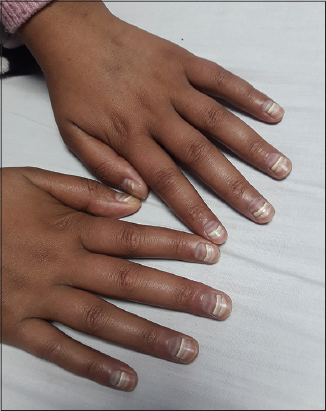|
Get Citation
|
|
|
Thapa DP. Chemotherapy induced Beau’s and Mee’s line simultaneously: a case report and review of literature. Our Dermatol Online. 2019;10(1):77-78. |
|
|
Download citation file:
|
Chemotherapy induced Beau’s and Mee’s line simultaneously: A case report and review of literature
Deeptara Pathak Thapa
Nepal medical college and Teaching hospital, Kathmandu, Nepal
Corresponding author: Dr. Deeptara Pathak Thapa, E-mail: drdeeptarapathak@yahoo.com
Submission: 16.07.2018; Acceptance: 18.11.2018
DOI:10.7241/ourd.20191.21
ABSTRACT
Chemotherapy affect skin and its appendages. Nail changes due to chemotherapeutic agents are common asymptomatic and usually resolve after discontinuation of therapy. There are various chemotherapeutic agents implicated for the changes like vincristine, hydroxyurea, etoposide, daunorubicin, bleomycin, cyclophosphamide etc. We report a case undergoing chemotherapy with etoposide and cyclophosphamide who had beau’s and Mee’s line simultaneously. Clinical acumen including history taking, knowledge about chemotherapy induced nail changes, counselling of the patient are prerequisite to diagnose such cases deferring unnecessary diagnostic workup and treatment.
Key words: Beu’s line, Etoposide, Mee’s line
INTRODUCTION
Chemotherapeutics agents can have not only systemic but as well as mucocutaneous side effects. Nail changes are common like nail dystrophies, chromonychia, leukonychia (including Mee’s and Muehrcke’s lines), Beau’s lines, paronychia and onycholysis following anticancer drugs [1,2]. Few case reports has been mentioned in the literature of simultaneous appearance of the Mee’s lines and Beu’s lines in same patient.
CASE REPORT
A 20 year girl, diagnosed as Ewing sarcoma receiving chemotherapy including cyclophosphamide and Etoposide presented with multiple white continuous transverse bands with regular intervals covering whole width of nail plates with transverse depressions of fingernails and toenails as shown in Fig 1. During chemotherapy cycle white transverse lines moves distally as the nail grew, and new stripes developed after each cycle. She noticed this nail changes after starting of chemotherapy and completed 4 cycle till now. There were no history of any arsenic exposure or any medical illness in our patient. This white lines are called Mee’s line and transverse depression are called Beu’s lines. Patient was counseled about the nail changes due to chemotherapy.
DISCUSSION
Nail abnormalities due to result from drug toxicity leads to the matrix, nail bed, periungual tissues or digital blood vessels involvement. Chemotherapy agents implicated are – vincristine, hydroxyurea, etoposide, daunorubicin, bleomycin, cyclophosphamide, dacarbazine, 5-fluorouracil and methotrexate [2–4].
Mee’s lines and Beu’s lines occur due to temporary arrest of proliferative function of the nail matrix with cytotoxic chemotherapeutic agents. Mees’ lines are signs of toxicity to the distal nail matrix, disorganized keratinization of the nail matrix leads to parakeratosis of the nail plate, which becomes white and opaque. True leukonychia (Mees’ lines) due to drug toxicity shows as one or several parallel transverse white bands affecting all nails at the same level and which moves distally with nail growth. Leukonychia is seen in arsenic and thallium intoxication and also had been reported in various medical diseases such as myocardial infarction, acute and chronic renal failure, kidney allograft rejection, systemic lupus erythematosus, immune hemolytic anemia and Hodgkin’s disease [5]. Beu’s lines are signs of acute toxicity to the nail matrix with transient arrest in nail plate production due to decrease in matrix cell proliferation which are associated with temporary cessation of nail growth according to cycles of chemotherapy shows a transverse depression that migrates distally as the nail grows.
There is difference of proliferative potential between fingernails and toenails which leads to different clinical manifestations as per Kim et al. Rapid mitotic activity having organs are likely to damaged more severely from chemotherapy in much the same way fingernails are more vulnerable to anticancer drugs than toenails but in his case report rapidly proliferating fingernails were less affected by chemotherapeutic nail matrix damage; consequently, less severe depression and less opaque Mees’ lines manifested. The depth of the depression indicates the degree of the damage, and the width indicates the duration of the insult [6]. We are reporting nail changes like Beau’s line or Mees’ line occurring in a same patient after chemotherapy for the first time from our part of the world. There are only two case reports, having both Mees lines and Beus lines had been previously reported in the literature till date [6,7]. The most common nail finding observed was melanonychia which was seen in 26 (78.7%) patients, followed by Muehrcke’s lines, Mee’s lines, and Beau’s lines [8]. Nail changes can be the only symptoms after chemotherapy so a good history, knowledge about nail changes following chemotherapy, counselling of the patient and good clinical acumen is necessary to diagnose such cases alleviating unnecessary diagnostic workup and treatment.
CONSENT
The examination of the patient was conducted according to the Declaration of Helsinki principles.
REFERENCES
1. Gupta A, Parakh A, Dubey AP. Chemotherapy induced nail changes. Indian J Dermatol. 2008;53:204-5.
2. Hinds G, Thomas VD. Malignancy and cancer treatment- related hair and nail changes. Dermatol Clin. 2008;26:59–68.
3. Dasanu CA, Vaillant JG, Alexandrescu DT. Distinct patterns of chromonychia, Beau’s lines and melanoderma seen with vincristine, adriamycin, dexamethasone for multiple myeloma. Dermatol Online J. 2006;12:10.
4. Chang P, Vásquez Acajabón MV. Beau´s lines due to cytostatic drugs in a patient with breast cancer. Our Dermatol Online. 2014;5:198 200.
5. Piraccini BM, Iorizzo M, Tosti A. Drug-induced nail abnormalities. Am J Clin Dermatol. 2003;4:31–7.
6. Kim IS, Lee JW, Park KY, Li K, Seo SJ, Hong CK. Nail change after chemotherapy:simultaneous development of Beau’s lines and Mees’lines. Ann Dermatol. 2012;24:238-9.
7. Kinjo T, Shibahara D, Higa F, Fujita J. Beau’s Lines and Mees’Lines Formations after chemotherapy. Intern Med. 2015;54:2281.
8. Pavey RA, Kambil SM, Bhat RM. Dermatological adverse reactions to cancer chemotherapy. Indian J Dermatol Venereol Leprol. 2015;81:434.
Notes
Source of Support: Nil
Conflict of Interest: None declared.

Comments are closed.